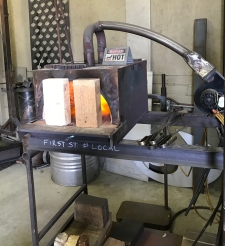
Hamilton Dixon combines his artistry and expertise in metalwork with his interest in old buildings to thrive as a full-time metalwork sculptor and entrepreneur.
In the beginning…
Growing up in Rome, Georgia, Hamilton Dixon “was a bit of a loner. We lived on a piece of property that wasn’t near many other houses, so I spent a lot of time charging around through the woods by myself with my dog, rigging up booby-traps for invisible bad guys”. His father collected cars, mainly Morgans.

“He ended up opening a car shop to buy cars, fix them up, and sell them”. Hamilton spent time there “learning to be mechanical and how to weld”.
How did Hamilton build his metalworking skills?
“I had some welding classes in high school and I really liked that”. Hamilton also had a friend in Jasper, Georgia who worked with metal in an old-style blacksmith shop. “He’d heat metal up in a forge and hammer it on an anvil and he was very particular about techniques. And that interested me a lot”.
Following high school, Hamilton joined a friend to work “offshore on an oilrig out in the Gulf of Mexico, just trying to find my way. I liked the welding and fabrication. It was grueling work. You’re on 12 hours and you’re off 12 hours. When you’re off, you aren’t doing anything but sleeping, because you’re just totally ruined”.
After about a year of working on the oilrig, Hamilton traveled to Santa Fe, New Mexico to hone his metal working skills at Turley Forge Blacksmithing School .

Then Hamilton returned to Rome, Georgia and began “tinkering around” in his father’s car shop. When his dad decided the car shop was no longer a viable enterprise, “I kept the building and started doing stuff on my own”.
How did Hamilton build his reputation as a metalwork sculptor?

“Somebody said, ‘Hey, they’re doing a streetscape project for Rome, Georgia. Do you have any good ideas for a bench?’” Hamilton immediately produced a sketch, which the project planners liked. After some negotiation, they ordered 60. Eventually, he made over 200 benches and sold them to other communities and some colleges. “So that kind of put me on the map with people”.
How did Hamilton transition to Dayton?
In 1990 Hamilton relocated to Dayton, Ohio to join friends. Following a search, he found inexpensive space for his shop in The Front Street Building in downtown Dayton.

“That was my headquarters. I knew everyone in Front Street and pretty soon I got a couple projects”.
During the Dayton Art Institute renovation in 1997, the planners asked Hamilton to submit a design for the rotunda handrail. After lengthy negotiations and revised drawings, the planners selected his design.

“It was 130 feet of huge railing. That is a lot of forged steel”. Since he was on a tight schedule, “everyone who ever stopped by and hung out at my shop…helped do portions of that railing”.
“After I did that railing, I was getting calls to do all sorts of stuff for all sorts of people – interior railings and you name it. So that’s what I’ve done ever since”.
What is Hamilton’s process to go from a drawing to a finished piece?
Often people have seen one of Hamilton’s existing pieces and ask for something similar. “I’ve always been able to draw just free-hand drawings of a thing. That’s how I talk to a customer”. He sketches his idea, they discuss it, and then he does a more refined drawing. At that point, they generally reach an agreement and Hamilton begins production.

“I’m at the person’s house, and I’ll draw on a piece of paper. When I come to the shop, I’ll do a drawing on the table. I figure out life size – how big is that from here to here, how much steel is that? I literally lay a flexible tape measure on that and I’ll just measure the length. All the steel I use starts out as straight bars of steel.”
The size, shape, and textures of the design determine Hamilton’s next steps. In order to bend and shape the metal, he fires the natural gas forge he built, which can be heated to 2,000 degrees. “A piece of steel can be heated up to bright red in about 15 minutes” and ready to shape.

For certain effects, Hamilton hammers metal manually on his anvil. “Basically I have to beat the crap out of it to achieve the textural element”.
For pieces requiring greater force, he uses a power hammer built in the 1940’s acquired from an old metal shop and foundry in Rome, Georgia. “I can hold steel with both hands and then operate this machine. I can hammer steel pretty quickly this way.”

To create twisted shapes, “I rush from the forge with a piece of bright red steel” and clamp it in the vise. “I get a big crescent wrench and a big leverage bar. I’ll put a bunch of pressure on it and begin to twist it. Sometimes I hang on it with my entire body weight and other times, I can just twist it easily with one arm. The bigger the piece is, the more difficult it is, but the longer it will stay hot. The smaller it is, it will cool off so quickly that you have to rush”.

“I learned a lot of that stuff from the guy in Jasper, Georgia. It’s the same technique as doing little stuff with little jewelry. There’s a million steps to working with metal”.
How did Hamilton get started renovating old buildings?
Hamilton and his wife, Carli, were friends for a long time before they became a couple. Their first adventure renovating an old building together started when they were deciding where to live after the birth of their first child. They quickly realized Carli’s house was too small for a baby and Hamilton’s collections. They put her house up for sale and began renovating Hamilton’s 1876 house, which needed a lot of work. “There’s no electric and there’s no running water and there’s no kitchen”. Carli’s house sold quickly, however, and the buyers wanted immediate occupancy. “So we had to move into my house and put a temporary wall up in the downstairs and live in the front half of my house with a new baby”. Ultimately, they finished the house.
When did Hamilton combine renovating old buildings with his metalwork?
Driving into Dayton, Hamilton frequently passed a block of old buildings for sale. “It was basically cordoned off and this building was boarded up”. When Hamilton wanted to move his shop out of The Front Street Building, he and Carli walked through the buildings and the “giant rooms” sparked their imagination.

The sellers didn’t want to separate the three parcels – the 18,000 sq. ft. building (905 E. 3rd St), the Atta Boy gas station (817 E. 3rd St) and a smaller building (811 E. 3rd St), but Hamilton and Carli didn’t need all that space. They made an offer for the smaller building that was declined. After a year, “we got a nudge to go make them another offer. We worked some miracles financially and made them an offer for the whole parcel.” After a lot of negotiation, they struck a deal.

In the first phase of renovation, Hamilton set up his shop in the smaller building, rebuilding the floor and adding three-phase power for his machines. In the next phase, they tackled the larger 1880’s era building. “It was full of abandoned donations for Hurricane Katrina victims. It was pitch-black dark in there; everything was boarded up”. Hamilton and Carli spent thousands of dollars to bring the building up to code and install utilities.
Then they rented space on the first floor to Shon Walters and the Zoot Theater Company. “So we were pulling in a little bit of rent”.

In time their tenants needed more space and moved out. By then Hamilton and Carli were ready to relocate her business, Bloombeads by freezeframe, from Clayton, Ohio. Since Carli’s business needed space both upstairs and downstairs for production and her showroom, they had to make additional renovations. “There was an old rickety stairway that went up into the ceiling and that was the only access to the upstairs. In order to have a legitimate upstairs, you had to have a code-meeting fire-rated stairwell”.
With help from family, friends and multiple contractors, Hamilton and Carli devoted the time and money necessary to clean out the building and redesign the area in the front. In 2013 they moved Bloombeads by freezeframe into the building.

Now they are in the next phase of their vision, creation of The Brightside Music and Event Venue. They completed the bar area in the room behind Carli’s showroom and are finishing the big back room. To learn more about their renovation efforts, watch their video story.
The Brightside offers a venue for music, parties, art shows, wedding receptions, and other events. They have a liquor license, “so we can now have our own programming going on here. We’re hoping to get a few more people to invest to get this final room breathing again”.
Hamilton’s observations:
- At first, to set the prices for the small pieces he started showing in small galleries, he looked at the prices charged by other artists for similar work. Once he sold a few pieces, he had a better feel for his base prices.

Functional sculpture, http://www.hamiltondixon.com Pricing big jobs was hard, though, because “I had no reference point”, but he discovered his “old friend down in Jasper, Georgia had good reference points for things like that; he helped me figure stuff out”. He also learned that asking customers the scope of their budget helps determine pricing.

Gates by Hamilton Dixon that will be repurposed to create a headboard - Hamilton and Carli work as a team. “Carli’s the brains behind the thing; she’s the one with the ability to juggle spreadsheets and employees,” while Hamilton provides a wide range of mechanical skills.
- When Hamilton is overwhelmed, Carli will break the project down into tasks. “A lot of times I’m paralyzed when I come to this building. There’s everything that needs to be done”. Carli will say, “’let’s just do this part right here first; just work with me for 30 minutes’. And four hours later, you’re almost done with the whole thing”.
- Hamilton advises, “Learn how to be self sufficient…learn how to do mechanical things, stuff you need instead of depending on someone else to do it for you”.
- In conclusion, Hamilton said, “Try to just do the things you know are good and right”.

You can learn more about Hamilton and view his sculptures and process at http://www.hamiltondixon.com/ You can find photos of Hamilton at work by Bill Franz at https://billfranz17.com/2015/08/09/hamilton-dixon-steel-sculptor/

For information, photos, and booking options for The Brightside Music & Event Venue go to: https://www.thebrightsidedayton.com/
In the Dayton area, Hamilton’s artistic metalwork can be found at the Dayton Art Institute Rotunda, University of Dayton Serenity Pines, the weather vane at Delco Park, the Kettering City Building, Hospice of Dayton entrance sculpture, and many other places.




